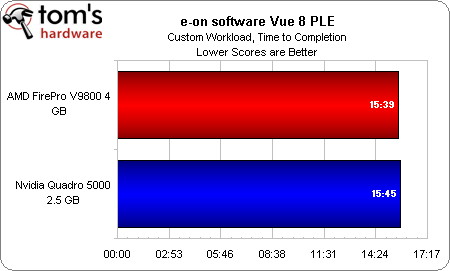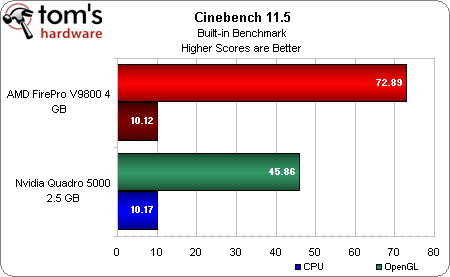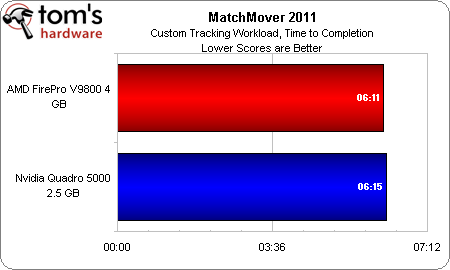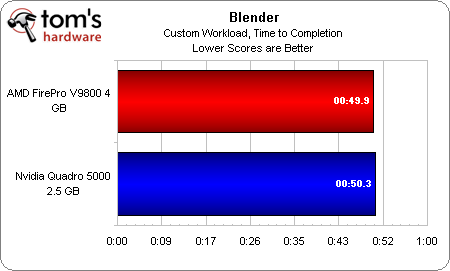AMD FirePro V9800 4 GB: Eyefinity Meets Professional Graphics
What's red, black, sports 4 GB of GDDR5, and has DisplayPort outputs all over? AMD's FirePro V9800, the company's ultra-high-end workstation card. We run it through a battery of SPECapc and real-world performance tests, then compare it to Quadro 5000.
Benchmark Results: Vue, Cinebench, MatchMover, And Blender
Despite our best efforts, most of the other workstation benchmarks we used seemed more processor-bound than anything. e-on’s Vue is the first example—our landscape render completed in roughly the same time on both graphics cards.
As expected, the CPU-oriented benchmark shows both systems performing comparably with our Core i7-980X. Once you move into OpenGL testing, though, AMD’s FirePro V9800 takes a commanding lead over Nvidia’s GF100-based Quadro 5000.
Per Wikipedia: “In cinematography, match moving is a visual-effects technique that allows the insertion of computer graphics into live-action footage with correct position, scale, orientation, and motion relative to the photographed objects in the shot. The term is used loosely to refer to several different ways of extracting motion information from a motion picture, particularly camera movement. Match moving is related to rotoscoping and photogrammetry. It is sometimes referred to as motion tracking.”
The first step in match moving is identifying and tracking features—and that’s what our MatchMover 2011 benchmark does, using custom footage taken by Jon Carroll on Hollywood’s Walk of Fame.
We saw in our Xeon 5600-series review that this test is very lightly threaded, showing almost no gain moving from 16 threads to 24. But it’s decidedly processor-bound—apparent by the fact that both graphics cards turn in nearly-identical times.
When I recently polled our readers for benchmark suggestions in 2011, Blender was at the top of your list. So, we’re adding it. In fact, we already have a scripted metric worked out for the open source, cross-platform content creation suite. The project here is decidedly CPU-limited though, as we see both test platforms finishing the workload at roughly the same time.
Get Tom's Hardware's best news and in-depth reviews, straight to your inbox.
Current page: Benchmark Results: Vue, Cinebench, MatchMover, And Blender
Prev Page Benchmark Results: Adobe CS5 Suite Next Page Benchmark Results: 3ds Max 2010 And LightWave 9.6-
Nvidia shines in the industrial/commercial/scientific market, with their driver team and CUDA/GPGPU tech. Too bad the V9800 fell short of expectations. Also, Nividia cards are obviously going to have better results in Adobe Mercury since both companies worked together on hardware optimization. AMD needs to be more aggressive in working together with software makers, (including games!) to have a stronger hold on both the CPU and GPU markets. Overall, a good read.Reply
-
reprotected It would actually make sense if they compared with the V8800 and the Quadro 6000. We also need a review of the Quadro 4000, 2000 and the 800, along with the lower Firepro 3D series.Reply -
reprotectedIt would actually make sense if they compared with the V8800 and the Quadro 6000. We also need a review of the Quadro 4000, 2000 and the 600, along with the lower Firepro 3D series.1. Definetly, a review of the "lower end" cards would be nice.Reply
2. Plus, it would be nice to see how well the SLi cards scale.
3. Also, with the updated (e)nVidia desktop cards (GF100 to GF110), will the Quadro ones see a revision too - if so, when? -
cangelini radiovan1. Definetly, a review of the "lower end" cards would be nice.2. Plus, it would be nice to see how well the SLi cards scale.3. Also, with the updated (e)nVidia desktop cards (GF100 to GF110), will the Quadro ones see a revision too - if so, when?Reply
Good question (3), I'll ask!
Cheers,
Chris -
Cwize1 This was a rather underwhelming test suit. I think the fundamental problem you have is that most of the tests you ran were CPU based.Reply
What most of these production apps use the GPU for is on the fly rendering. For example, sculpting in blender can tax the GPU quite nicely given enough vectors. Another good blender one would be playing back a super resolution baked fluid simulation in real time. For example, take the tom's hardware logo you had before, turn it into water and let the water fall onto a flat surface. Bake the simulation with a ridiculous resolution (as much as you can before blender crashes) and then play the simulation back in real time while watching 5 high definition videos at the same time. -
hell_storm2004 The FirePro has still the long way to go to catch up with the Quadro. I hope ATI makes good progress in the workstation models soon like they have come a long way in the desktop market.Reply -
eclecticfortune In this article's conclusion appeared this statement:Reply
"If you’re a creative professional working with Adobe’s CS5 suite, then the Quadro is hands-down a no-brainer."
Benchmarks indicate that the lower priced GTX 480 is a far better choice (cost effective)for those taking advantage of the Mercury Playback Engine running Premiere Pro CS5.
http://ppbm5.com/Benchmark5.html
At the top of this page, click on the "MPE Performance Chart" to get a comparison between the different Nvidia Cards with Premiere Pro CS5.




